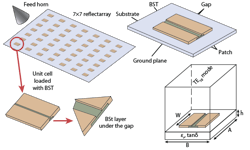Barium Strontium Titanate Tunes Variable Patch Antenna Reflectarrays
Realizing beamsteerable reflectarray antennas in millimeter-wave frequencies is a challenge drawing much interest from the space antenna market. As the demand is increasing for electronically reconfigurable antenna arrays with high data rates and fast switching speeds, designers are looking beyond traditional microwave switches and RF micro-electromechanical system (MEMS) technology. Researchers Kalyan K. Karnati, Parveen F. Wahid, Xun Gong, and Michael E. Trampler of the University of Central Florida, Ya Shen, along with TriQuint Semiconductor (now Qorvo) and Intellectual Ventures’ Siamak Ebadi, have developed integrated and tunable reflectarray unit cells in the Ka and X bands using barium strontium titanate (BST) tunable capacitors.
When the DC-bias of a thin-film of BST is adjusted, the dielectric properties of the material are changed. When monolithically integrated beneath the patch antenna element, a tuning mechanism for the antenna is possible without significant packaging and bonding parasitics and manufacturing challenges. Both full-wave electromagnetic simulations and practical measurements were performed to evaluate the designed operation.
When operating in a maximum phase range mode, the unit cells reached a phase range of 298 deg. and 263 deg. with a maximum reflection loss of 16 dB and 8.8 dB in the Ka- and X-bands. At a frequencies of minimum reflection loss, 30.7 GHz and 10.27 GHz, reflection losses of 5.6 DB and 5.8 dB were achieved with a phase angle of 250 deg.
See “A BST-Integrated Capacitively Loaded Patch for Ka- and X-band Beamsteerable Reflectarray Antennas in Satellite Communications,” IEEE Transactions on Antennas and Propagation, Apr. 2015, p. 1324.
About the Author
Jean-Jacques DeLisle
Jean-Jacques graduated from the Rochester Institute of Technology, where he completed his Master of Science in Electrical Engineering. In his studies, Jean-Jacques focused on Control Systems Design, Mixed-Signal IC Design, and RF Design. His research focus was in smart-sensor platform design for RF connector applications for the telecommunications industry. During his research, Jean-Jacques developed a passion for the field of RF/microwaves and expanded his knowledge by doing R&D for the telecommunications industry.
